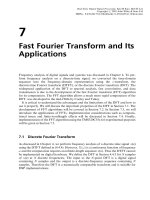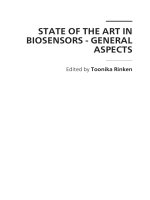- Trang chủ >>
- Khoa Học Tự Nhiên >>
- Vật lý
synthesis of pd or pt titanate nanotube and its application
Bạn đang xem bản rút gọn của tài liệu. Xem và tải ngay bản đầy đủ của tài liệu tại đây (1.31 MB, 6 trang )
A
vailable online at www.sciencedirect.com
Sensors and Actuators B 128 (2007) 320–325
Synthesis of Pd or Pt/titanate nanotube and its application
to catalytic type hydrogen gas sensor
Chi-Hwan Han
a
, Dae-Woong Hong
a
, Il-Jin Kim
a
, Jihye Gwak
a
,
Sang-Do Han
a,∗
, Krishan C. Singh
b
a
Photo- & Electro-Materials Research Center, Korea Institute of Energy Research, 71-2, Jangdong, Yuseong, Daejeon 305-343, Korea
b
Department of Chemistry, Maharshi Dayanand University, Rohtak 124001, India
Received 29 March 2007; received in revised form 20 June 2007; accepted 20 June 2007
Available online 27 June 2007
Abstract
A catalytic combustible gas sensor has been developed by using Pd and Pt/titanate nanotubes. Pd and Pt/titanate nanotube catalysts were
synthesized by a hydrothermal synthesis method. Sensors were fabricated by screen-printing of the catalytic material and a compensating material
on an alumina plate with a platinum heater. The sensor with Pd and Pt/titanate nanotubes showed higher response than that with conventional Pd
and Pt catalysts. This seems to be due to the evenly dispersed Pd and Pt catalysts on the titanate nanotubes at a nano-scale level, and the better
adsorption of hydrogen on the titanate nanotube surface which facilitates the oxidation of hydrogen by the Pd and Pt catalysts. The present flat-type
catalytic combustible hydrogen sensor is a good candidate for detection of hydrogen.
© 2007 Elsevier B.V. All rights reserved.
Keywords: H
2
; Gas sensor; Catalytic sensor; Pd/titanate nanotube; Pt/titanate nanotubes
1. Introduction
Catalytic combustion sensors are used primarily to detect
combustible gases. Combustible gas mixtures do not burn till
they reach an ignition temperature. However, in the presence
of certain chemical media, the gas ignites at lower temperature.
This phenomenon is known as a catalytic combustion [1–4].
Both metals and metal oxides have these catalytic properties.
Platinum and palladium are excellent catalysts for combustion.
The very high rate of reaction on the noble metals makes them
ideal for the detection, by calorimetric methods of reducing
gases at concentrations around lower explosive limits (LEL).
Catalytic sensors for detection of hydrogen up to 100% LEL
have been developed by many groups [1,5,6]. In these sensors,
reaction of hydrogen and oxygen on the sensing element (Pd
and Pt catalysts) causes a rise in its temperature. The tempera-
ture of the sensing element is generally compared with that of
a compensating element without catalysts. Commercially avail-
able catalytic gas sensors consist of a catalytic surface and a
∗
Corresponding author. Tel.: +82 42 860 3449; fax: +82 42 860 3307.
E-mail address: (S D. Han).
platinum wire as a temperature sensor and heater to maintain
the catalyst at the operating temperature. The catalytic surface
is generally prepared by sintering noble metal particles (Pt and
Pd) on a high surface area material like ␥-Al
2
O
3
, SnO
2
,TiO
2
and their mixtures. However, there are still certain limitations
associated with them. These sensors show low sensitivity due
to lack of adsorption sites for hydrogen, can only be operated at
high temperature, and are prone to catalytic poisoning [4,7].
Recently titania has attracted much attention for its oxygen
sensing capability [8–10]. Furthermore with proper manipula-
tion of the microstructure, crystalline phase and/or addition of
proper impurities or surface functionalization, titania can also
be used as a reducing gas sensor [11–13]. The interaction of
a gas with a metal oxide semiconductor is primarily a sur-
face phenomenon; therefore nano-porous metal oxides offer the
advantage of providing a large sensing surface area. Recently,
semiconducting oxide nano-wires which are usually stoichio-
metrically better defined and have a greater level of crystallinity
than the multi-granular oxides have been used in semiconductor
sensors for hydrogen [14–16].
The application of Pd or Pt dispersed on titanate nanotubes
(Pd and Pt/titanate nanotubes) in combustion type sensors has
not been exploited yet. We have synthesized Pd and Pt/titanate
0925-4005/$ – see front matter © 2007 Elsevier B.V. All rights reserved.
doi:10.1016/j.snb.2007.06.025
C H. Han et al. / Sensors and Actuators B 128 (2007) 320–325 321
nanotubes by a hydrothermal method and prepared a flat-type
catalytic combustion hydrogen sensor on an alumina substrate
using both Pd and Pt/titanate nanotubes as catalysts. The work-
ing of the sensors fabricated with Pd and Pt/titanate nanotubes
and TiO
2
nanoparticles has been compared and explained in the
present paper. The choice of H
2
as a test gas is driven by its
potential applications as a fuel in internal combustion engines,
fuel cell vehicles, and in manufacturing of many industrial chem-
icals like ammonia, methanol, gasoline, heating oil, rocket fuel,
etc. [17,18].
2. Experimental
The method employed for the synthesis of Pd and Pt/titanate
nanotubes was essentially the same as described by Ma et al.
[19]. Commercial anatase-type titania powder and PdCl
2
or
H
2
PtCl
6
in an equal amount (2 g each) were dispersed in an
aqueous solution of NaOH (10 M, 40 ml) and charged into a
Teflon-line autoclave. The autoclave was heated at 150
◦
C for
12 h for hydrothermal treatment. The precipitates were sepa-
rated by filtration and washed with dilute HCl and de-ionized
water. The synthesized Pd and Pt/titanate nanotubes were dried
at 120
◦
Cinanoven.
Synthesized Pd and Pt/titanate nanotubes were examined by
powder X-ray diffraction (XRD; Rigaku, Ultima plus diffrac-
tometer D/Max 2000). Particle morphology and size were
investigated by a field emission scanning electron microscope
(FE-SEM; Hitachi, S-4300) and a transmission electron micro-
scope (TEM; JEOL, JEM-3000F). Thermal analysis was carried
out using a simultaneous thermal analyzer (STA; Scinco, STA
S-1500) with a heating rate of 5
◦
C/min.
Fig. 1. Schematic diagram of (a) the sensor structure and (b) the fabricated
sensor. Dimensions are in micrometer.
Fig. 1 schematically shows the structure and size of the
present sensor device. The sensor device was fabricated in the
following procedure. A platinum micro-heater was formed on an
alumina plate by a screen-printing method with platinum paste
(METECH, Platinum conductor PCC 11417) and heat treat-
ment at 1000
◦
C for 10 min. The sensing element was formed
by screen-printing of a catalytic layer on the platinum heater,
followed by firing at 700
◦
C for 1 h in a muffle furnace. The
compensating element with an inert layer was also formed by
the same method. The sensing and compensating elements were
linked to signal pins of the sensor body by spot welding (WITH
Corporation, WMH-V1) with platinum wire (thickness: 30 m).
The compensating element formed one arm of the Wheatstone
bridge. The sensor element was connected in series with the
bridge, such that nearly the same current flowed through the
compensating element and the sensor element. The surface tem-
Fig. 2. Schematic view of the measuring system.
322 C H. Han et al. / Sensors and Actuators B 128 (2007) 320–325
perature of the sensor at each applied voltage was measured by
an IR radiation thermometer (Minolta IR 0506C).
The sensing material as a combustion catalyst for hydro-
gen was (a) Pd and Pt/titanate nanotubes (15 wt%) supported
on ␥-Al
2
O
3
(70 wt%), and the reference material to com-
pensate the heat capacity of it in a bridge circuit was
an inactive ␥-Al
2
O
3
film. For comparison, three type of
sensors coated with the following compositions were also pre-
pared; (b) titanate nanotubes (15 wt%) + Pd and Pt (PdCl
2
and
H
2
PtCl
6
15 wt%) + ␥-Al
2
O
3
(70 wt%), (c) TiO
2
nanoparticles
(15 wt%) + Pd and Pt (15 wt%) + ␥-Al
2
O
3
(70 wt%), and (d) Pd
and Pt (30 wt%) + ␥-Al
2
O
3
(70 wt%). TiO
2
nanoparticles were
purchased from Nanostructured & Amorphous Materials Inc.
The catalyst layers were screen-printed with a viscous paste,
which was a mixture of oxide powder and an organic vehicle.
The metal oxide powder material was mixed with an organic
vehicle at a concentration of 20 wt%, followed by ball-milling
for 24 h, to prepare the pastes suitable for screen-printing. The
organic vehicle was prepared by dissolving 10 g polyvinyl alco-
hol resin in a mixed solution of 13 mmol n-butyl alcohol and
350 mmol ␣-terpineol, followed by vigorous stirring at 80
◦
C.
All sensing experiments were carried out using a thermostatic
environmental test chamber connected with a signal interface
and power controller, as shown in Fig. 2. Freshairwas introduced
and then the gas inlet and outlet of the chamber were closed.
The device was exposed to a hydrogen gas sample for ∼5 s for
gas response test, and the device was recovered by exposing to
purified air again. Dry hydrogen and air from commercial gas
cylinders were mixed in a desired ratio. Mass flow controllers
were used to set the hydrogen and air flow rates. The output
voltages of the sensor were measured when the chamber reached
Fig. 3. The measured and calculated temperature vs. heater voltage.
to desirable conditions. The sensor response V was defined as
the difference between the output voltage in a sample gas (V
g
)
and that in air (V
a
): V = V
g
− V
a
.
3. Results and discussion
3.1. Calibration of platinum heater
Changes in the platinum heater resistance were monitored
when a linearly increasing current was applied to the heater.
The resistance was converted to sensor temperature according
to the well-known equation [20]:
R
T 2
= R
T 1
[1 + α(T
2
− T
1
)]
Fig. 4. SEM images of (a) Pd/titanate nanotubes, (b) Pt/titanate nanotubes, (c) titanate nanotubes, and (d) TiO
2
nanoparticles.
C H. Han et al. / Sensors and Actuators B 128 (2007) 320–325 323
Fig. 5. EDAX mapping results of Pd/titanate nanotubes. Red dots are of Ti and
green dots are of Pd. (For interpretation of the references to color in this figure
legend, the reader is referred to the web version of the article.)
where R
T1
is the resistanceat the initial temperature T
1
, R
T2
is the
resistance at the final temperature T
2
, and ␣ is the temperature
coefficient (+0.00377/
◦
C).
The calculated temperature of the heater was compared with
the measured temperature by the IR thermometer and presented
in Fig. 3. It can be seen that the measured and calculated tem-
peratures at different applied heater voltages well agreed with
each other. Thus, it could be concluded that the platinum heater
fabricated by screen-printing from platinum paste had the same
characteristics of the conventional platinum heater.
3.2. Characterization of Pd or Pt/titanate nanotube
Fig. 4 showed typical SEM images showing uniform nature of
nanotubes having approximately 100 nm diameters. Nanotubes
were found to be entangled with each other. Fig. 5 showed the
EDAX mapping result of Pd/titanate nanotube. Thedispersion of
Pd on the nanotubes is uniform as depicted in Fig. 5. The EDAX
spectra also identified that the nanotubes are composed of Ti,
Pd and O. There is almost no Na recorded in nanotubes. Taking
into consideration of H
•
, the synthesized titanate nanotubes are
attributed to protonic titanate consistent with the previous stud-
Fig. 7. XRD results of (a) Pd/titanate nanotubes, (b) Pt/titanate nanotubes, (c)
titanate nanotubes, (d) TiO
2
nanoparticles. PdO (*), Pt metal (**).
ies [19].InFig. 6, typical TEM images demonstrate uniformly
sized nanotubes over which Pt or Pd nanoparticles are randomly
distributed. The outer diameter of the nanotubes in TEM image
is again approximately 100 nm, and it is consistent with the SEM
images.
In Fig. 7, XRD patterns of Pd and Pt/titanate nanotubes
are presented and compared with that of titanate nanotubes
synthesized in the absence of Pd or Pt. All the three
samples are basically having the same identical structures.
The peaks 2θ = 9.5, 24.5, 28, 48 and 62 can readily be
indexed to lepidocrocite-type titanate phase (e.g., orthorhom-
bic H
2
Ti
2−x/4
x/4
O
4
, a = 0.3643, b = 1.8735 and C = 0.2978 nm)
and correspond well with 0 2 0, 1 1 0, 1 3 0, 2 0 0 and 0 0 2 reflec-
tions. For Pd and Pt/titanate nanotubes, additional peaks from
PdO and Pt metal were identified, as shown in Fig. 7a and b,
respectively. Thus, Pd and Pt exist over the titanate nanotube
surface as an oxide form and a metal form, respectively.
Fig. 8 showed TG/DTA curves of Pt and Pd/titanate nan-
otubes. The nanotubes showed ∼13% weight loss after heated to
1000
◦
C and nearly 6% weight loss was found up to 300
◦
C. The
curves of Pt and Pd/titanate nanotubes were almost identical.
Fig. 6. TEM images of (a) Pd/titanate and (b) Pt/titanate nanotubes.
324 C H. Han et al. / Sensors and Actuators B 128 (2007) 320–325
Fig. 8. TG/DTA results of (a) Pd/titanate and (b) Pt/titanate nanotubes.
This demonstrates that the presence of Pd nanoparticles over
titanate nanotubes does not change the crystalline nature of the
tubes. Our TG curves are slightly different from that of Ma
et al. [19]. Weight losses of 10% up to 140
◦
C and 13% after
1000
◦
C heating have been found in their curves.
3.3. Evaluation of sensor performance
Fig. 9 shows the responses of typical sensors pre-
pared with the compositions of (a) Pd and Pt/titanate
nanotubes (30 wt%) + ␥-Al
2
O
3
(70 wt%), (b) titanate nan-
otubes (15 wt%) + Pd and Pt (15 wt%) + ␥-Al
2
O
3
(70 wt%), (c)
Fig. 9. Response of sensors using various catalysts.
TiO
2
nanoparticles (15 wt%) + Pd and Pt (15 wt%) + ␥-Al
2
O
3
(70 wt%) and (d) Pd and Pt (30 wt%) + ␥-Al
2
O
3
(70 wt%) to 1%
hydrogen concentration in air at different heater temperatures.
The maximum sensor response (V) can be achieved at nearly
250
◦
C. The sensor response of composition (a) is almost twice
larger than those of the sensors of compositions (b), (c) and (d).
The sensor response of composition (a) at 118
◦
C is almost equal
to that of composition (b) at 250
◦
C.
Generally catalytic gas sensors (Pd and Pt dispersed on ␥-
Al
2
O
3
) become sensitive only at high temperature. Various
parameters such as crystalline size, film thickness, porosity,
amount and nature of dopants, surface oxides and catalysts are
known to be important in enhancing the gas sensitivity of the
sensors [2]. A thick film of polytetrafluoroethylene (PTFE) on
the Pd and Pt dispersed Al
2
O
3
surface is found to be resistant to
catalytic poisoning and reduce the sensor’s maximum response
temperature to 120
◦
C [4]. We have also reported reduced maxi-
mum temperature of a flat-type catalytic hydrogen sensor using
TiO
2
and UV LED [21].
It is well-known that noble metals like Pt and Pd are particu-
larly active for oxidation reactions because the heat of adsorption
of oxygen on noble metals is sufficiently low to allow relatively
low activation energy of oxidation and consequently a rapid rate
of reaction. In Fig. 9, the operational temperature for maximum
response for all the sensors was around 250
◦
C. This is the tem-
perature at which the rate of reaction on the catalytic surface
is fastest, resulting in a large change of temperature and conse-
quently a large change of voltage in the circuit. For the sensors
(b), (c) and (d), the magnitude of maximum response at 250
◦
C
is almost the same. This indicates that the catalytic activity of
Pt and Pd is not affected by the presence or absence of TiO
2
nanoparticles or nanotubes. However, the response of sensor
(a) is almost twice as large as those of the sensors (b), (c) and
(d). This indicates that the rate of oxidation reaction on Pd and
Pt/titanate nanotube surfaces is almost twice as large as those on
the other catalysts. This also suggests that the number of adsorp-
tion sites or the catalytic surface area has increased considerably.
This is only possible if the size of Pd or Pt particles on titanate
nanotubes is in nano-scale, which can be observed from TEM
Fig. 10. The relation between the sensor response and hydrogen concentration
at an applied voltage of 4 V.
C H. Han et al. / Sensors and Actuators B 128 (2007) 320–325 325
images of Pd and Pt/titanate nanotubes. Another reason for the
enhanced response of sensor (a) may be due to better adsorption
of hydrogen on the titanate nanotube surface which facilitates the
oxidation of hydrogen reaction by the Pd and Pt catalysts on the
titanate nanotube surface. For sensor (b) which is also fabricated
with titanate nanotubes and (Pd, Pt) catalysts, no enhancement
of response was observed. This may be due to the absence of (Pd,
Pt) catalysts on the titanate nanotube surface. In this case, hydro-
gen adsorbed on titanate nanotubes could not be easily oxidized
because the (Pd, Pt) catalysts existed apart from the nanotubes.
Fig. 10 depicts the variation of sensor voltage with the vari-
ation of hydrogen concentration at an operating temperature
of 250
◦
C. A linear relationship between the voltage and the
hydrogen concentration up to 3% of hydrogen is found.
4. Conclusion
It may be concluded that the catalytic gas sensor fabricated
with Pd and Pt/titanate nanotubes shows better response than the
sensors fabricated with TiO
2
nanoparticles or titanate nanotubes.
The enhanced sensitivity of the Pd and Pt/titanate nanotube sen-
sor may be due to faster reaction between adsorbed O
2
and H
2
.
The direct adsorption of hydrogen on the titanate nanotube sur-
face facilitates the oxidation reaction of hydrogen by Pd and Pt
catalysts evenly dispersed at a nano-scale level on the titanate
nanotubes.
Acknowledgements
This research was performed for the Hydrogen Energy R&D
Center, one of the 21st Century Frontier R&D Programs, funded
by the Ministry of Science and Technology of Korea.
References
[1] D.W. Dabill, S.J. Gentry, P.T. Walsh, A fast response catalytic sensor for
flammable gases, Sens. Actuators 11 (1987) 135–143.
[2] P.T. Moseley, B.C. Tofield, Solid State Gas Sensor, IOP Publishing Ltds.,
Bristal, UK, 1987.
[3] S.J. Gentry, T.A. Jones, The role of catalysts in solid-state gas sensors,
Sens. Actuators 10 (1986) 141–163.
[4] V.R. Katti, A.K. Dehnath, S.C. Gadkari, S.K. Gupta, V.C. Sahni, Passivated
thick film catalytic type H
2
sensor operating at low temperature, Sens.
Actuators B 84 (2002) 219–225.
[5] M.G. Jones, T.G. Nevell, The detection of hydrogen using catalytic
flammable gas sensors, Sens. Actuators 16 (1989) 215–224.
[6] J.B. Miller, C. Hort, T.B. Scheffler, Catalytic sensor, U.S. Patent No.
6911180132 (2005).
[7] S.J. Gentry, P.T. Walsh, The influence of high methane concentration on
the stability of catalytic flammable gas sensing elements, Sens. Actuators
5 (1984) 229–238.
[8] Y. Xu, K. Yao, X. Zhou, Q. Cao, Platinum–titania oxygen sensors and their
sensing mechanisms, Sens. Actuators B 14 (1993) 492–494.
[9] R. Rothschild, F. Edelman, X. Komem, F. Cosandey, Sensing behavior of
TiO
2
thin films exposed to air at low temperatures, Sens. Actuators B 67
(2000) 282–289.
[10] S. Hasegawa, Y.Sasaki, S.Matsuhara, Oxygen sensingfactor of TiO
2
doped
with metal ions, Sens. Actuators 14 (1993) 509–510.
[11] Y. Shimizu, N. Kuwano, T. Hyodo, M. Egashira, High H
2
sensing perfor-
mance of anodicallyoxydiged TiO
2
film contained withPd, Sens. Actuators
B 83 (2002) 195–201.
[12] H. Tang, K. Prasad, R. Sanjines, F. Levy, TiO
2
anatase thin films as gas
sensor, Sens. Actuators B 26 (1995) 71–75.
[13] N.O. Savage, S.A. Akbar, P.K. Dutta, Titanium dioxide based high tem-
perature carbon monoxide selective sensors, Sens. Actuators B 72 (2001)
239–248.
[14] O.K. Varghese, D. Gong, M. Paulose, K.G. Ong, C.A. Grimes, Hydro-
gen sensing using titania nanotubes, Sens. Actuators B 93 (2003) 338–
344.
[15] A. Kalmakov, M. Moskovits, Chemical sensing and catalysis by one
dimensional metal-oxide nanostructures, Annu. Rev. Mater. Res. 34 (2004)
151–180.
[16] O.K. Varghese, D. Gong, M. Paulose, K.G. Ong, E.C. Dickey, C.A. Grimes,
Extreme change in electrical resistance of titania nanotubes with hydrogen
exposure, Adv. Mater. 15 (2003) 624–627.
[17] D.C. Young, G.A. Mill, R. Wall, Feasibility of renewable energy storage
using hydrogen in remote communities in Bhutan, Int. J. Hydrogen Energy
32 (2007) 997–1009.
[18] V.A. Goltsov, T.N. Veziroglu, A step on the road to hydrogen civilization,
Int. J. Hydrogen Energy 27 (2004) 719–723.
[19] R. Ma, Y. Bando, T. Sasaki, Nanotubes of lepidocrocite titanates, Chem.
Phys. Lett. 380 (2003) 577–582.
[20] J.J. Carr, Sensors & Curcuit, PTR Prentice Hall, Englewood Cliffs, New
Jersey, 1993, p. 75.
[21] C H. Han, D W. Hong, S D. Han, J. Gwak, K.C. Singh, Catalytic com-
bustion type hydrogen gas sensor using TiO2 and UV-LED, Sens. Actuators
B 125 (2007) 224–228.
Biographies
Chi-Hwan Han received his PhD degree in physical chemistry from Korea
University, Seoul Korea in 2001. He worked at Bordeaux 1 University as a post-
doctoral fellow in 2002–2003. At present he is working in the Photo & Electro
Materials ResearchCenter, Korea Instituteof Energy Research (KIER),Daejeon,
Korea. His areas of interest are (i) nano sensing materials, (ii) micro-electro
mechanical system (MEMS), and (iii) electro luminescent phosphors.
Dae-Woong Hong received his BSc degree in electronics engineering from
Chungnam National University, Daejeon, Korea in 2006.He is currently a master
course student at the Yonsei University, Seoul, Korea. His areas of interest are
(i) catalytic reaction, and (ii) catalytic sensor modules.
Il-Jin Kim received his PhD degree in the department of electronics engineering
from Chung-Nam National University, Daejeon, Korea in 2006. He worked at
ASM Genitech Co. Ltd., Korea in 2000–2003. At present he is working in the
Photo & Electro Materials Research Center, KIER, Daejeon, Korea. His areas
of interest are (i) man machine interface systems (MMI) and programming, (ii)
MEMS and (iii) fabrication of micro chemical sensors.
Jihye Gwak received her PhD degree in materials from Universit
´
e Montpellier
II, Montpellier, France in 2003. She worked at theNational Institute forMaterials
Science (NIMS), Japan in 2003–2005. She has been working at KIER, Daejeon,
Korea, since September 2005. Her areas of interest are (i) nano-ceramic mate-
rials, (ii) luminescent materials & devices, (iii) porous inorganic materials &
membranes, (iv) sol–gel science, and (v) chemical sensors.
Sang-Do Han received his PhD degree in solid state chemistry from Bordeaux
1 University, France in 1994. He worked at LG Semiconductors Co. Ltd., in
1978–1980. He joined KIER, Daejeon, in 1980. His areas of interest are (i)
electronic and electrolyte materials, (ii) chemical sensors and (iii) hydrogen
production.
Krishan C. Singh received his PhD degree in chemistry from M.D. University
Rohtak, Haryana, India in 1980. He has been working as a lecturer and profes-
sor since 1980 in the same university. His major research field is the solution
thermodynamics, electrochemistry, phosphor materials and chemical sensors.
At present he is visiting scientist at KIER, under an agreement between KIER
and M.D. University. His research team has collaboration with KIER for 7 years
for synthesizing advanced materials.









